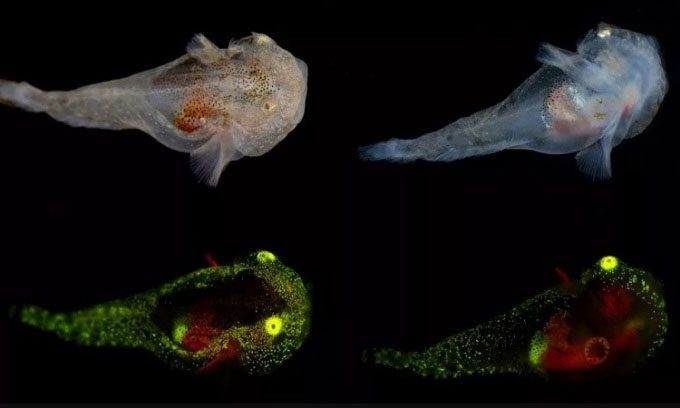Scientists have drilled deep beneath the icebergs off the coast of Greenland and discovered a species of fish with a green fluorescent antifreeze flowing through its bloodstream.
The spotted snailfish (Liparis gibbus), in its juvenile stage, contains the highest levels of antifreeze proteins ever recorded, according to a study published on August 16 in the journal Evolutionary Bioinformatics. Similar to the antifreeze that helps regulate car engine temperatures in extreme conditions, some species have evolved with similar capabilities, particularly organisms living in the frigid environments of the Arctic seas off Greenland.

Spotted snailfish captured under white light. (Photo: John Sparks and David Gruber)
“Antifreeze proteins attach to the surface of smaller ice crystals, preventing them from growing into larger, more hazardous crystals,” said co-author David Gruber, a biology professor at Baruch College, City University of New York. “Fish from both Antarctica and the Arctic have independently evolved this type of protein.”
Antifreeze proteins were first discovered in some Antarctic fish nearly 50 years ago, according to the National Academy of Sciences. Unlike many cold-blooded reptiles and insects, fish cannot survive if their bodily fluids freeze, leading to ice crystals forming within their cells. The snailfish produces antifreeze proteins like any other protein, which are then secreted into the bloodstream, Gruber explained.
Scientists found the spotted snailfish in 2019 during an expedition exploring icebergs off the coast of Greenland. During the trip, they were astonished to witness the snailfish’s green and red bioluminescence in the icy environment. “Snailfish are one of the few fish species living among the icebergs, in small niches. It’s surprising that such a tiny fish can survive in such extreme cold without freezing,” Gruber shared.
Fish in the Arctic rarely exhibit bioluminescent traits, the ability to convert blue light into green, red, or yellow, due to the prolonged darkness during winter in polar regions. Typically, this trait is more common in fish swimming in warmer waters.
The research team examined the bioluminescent characteristics of the snailfish and found two different types of genes that encode antifreeze proteins, adaptations that help them avoid becoming “ice fish.” The extremely high levels of antifreeze proteins may help the snailfish adapt to sub-zero environments. However, experts are uncertain how they will survive as ocean temperatures rise due to global warming.





















































